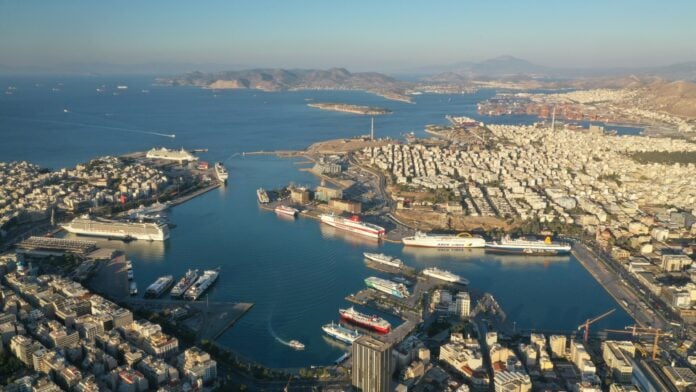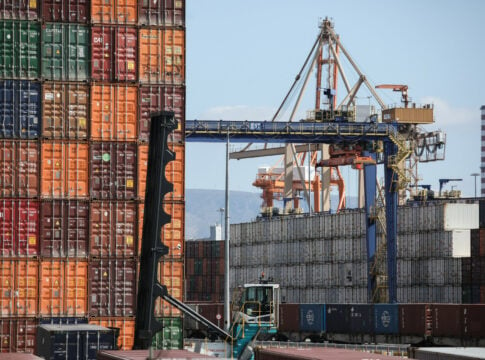Piraeus port-city is in Attica, in southern Greece. Piraeus municipality is the 5th largest in Greece. The city was founded in early 5th century BC.
Today, is a large city, recognized as an important commercial, cultural, and industrial center.
Piraeus port is located at the crossroads of Europe, Asia, and Africa. It is the biggest port in Greece and the eastern Mediterranean Sea, the 4th largest port in Europe and the 24th-largest container one globally.
In the following, the new era of sustainable port-cities is analyzed based on a port concept that aims at a more inclusive, stakeholder-centered approach of “building with nature” and pursues a participatory strategy involving local communities, environmental organizations and port authorities.
Efficiency, responsibility and resilience are key principles of a port sustainability plan. The measures to create sustainable seaports are in line with emerging trends in the industry and make use of innovative technologies. They are implemented in accordance with the specific characteristics of each port.
It would be useful to implement this approach in the case of the port of Piraeus in order to assess its current status and explore ways to improve its sustainable character.
Ports are marine basins which through physical topography, bathymetry and various technical constructions are characterized as closed or semi-closed coastal systems with limited water circulation. Ports where there are high levels of vessel, urban and industrial activity may be considered as contaminated areas.
The result is environmental degradation with potential negative impacts on the wellbeing of marine biocommunities and consequences upon the local and regional economy.
Ports attract shipping traffic and are places of concentrated emissions. Greenhouse gas emissions are caused by a variety of port operations and activities. On the other hand, ports, being in coastal areas, are immediately impacted by the consequences of increasing sea levels and other climate disturbances. Enhancing the climate resilience of a port is a matter of strategic socio-economic importance for the global economy and society.
Ports play a significant role regarding the international targets set by the 2030 Agenda for sustainable development and the Paris agreement.
In line with other major industries, ports strive to achieve suitable environmental management system and environmental policy. The environmental management system furnishes the processes and procedures to control and improve the environmental consequences.
The environmental policy corresponds to any deliberately taken action to manage human activities aiming at prevention, reduction, and mitigation of harmful effects, incorporating issues such as air and water pollution, waste, and ecosystem management.
The port industry acknowledges that environmental management has changed throughout time, encompassing not only the quayside and surrounding areas but also the entire port region, port-city connections, and the hinterland logistics chain.
The incorporation of ecologically friendly practices into port operations, administration, and activities is the idea of “sustainability” for ports. Future ports are dedicated to promoting environmental sustainability while fostering wealth for both present and future generations. A critical step is to identify the most significant activities giving rise to pressures affecting the environmental status in ports. These activities and pressures can vary depending on the location and context of the port, including air and water pollution, greenhouse gas emissions, waste management, ballast water treatment, hazardous materials handling, oil spills, noise pollution, energy consumption.
Implementing the green port concept will result in environmental, operational, and commercial benefits. Decarbonization is key to advent of a sustainable blue economy.
Adopting strategies for mitigating greenhouse gas emissions involves protecting operational sustainability and global responsibility.
Furthermore, ports possess the capacity to act as stimulants for the advancement of sustainability in the maritime and logistics sectors, thus fostering the adoption of eco-friendly practices by other relevant parties. Ports can encourage visiting ships to adopt best practices, such as reducing carbon emissions, by providing discounts on port fees for ocean-going ships that perform better in reducing air emissions.
This is what many ports around the world are doing through the Environmental Ship Index.
According to the EcoPorts Initiative, the top 10 environmental priorities of European ports include air quality, climate change, energy efficiency, noise, relationship with local community, ship waste, water quality, garbage/port waste, dredging operations and port development (land related).
A sustainable seaport requires the implementation of policies and regulations to cut the release of hazardous substances. A green design of the port-city area which includes trees results in a reduction of noise pollution and absorption of carbon dioxide. Moving to electric power and other sustainable and future fuel and the use of renewable energy sources improve carbon footprint of a port. Cold ironing is an example of efficient energy using.
Identifying reuse and recycling opportunities and implementing a solid waste segregation plan helps a lot. Dredging is a common practice to maintain navigable depth and facilitate maritime commerce. However, the practice has challenges as it can have adverse environmental consequences depending on the hydrological conditions.
The extraction and disposal of bottom sediments affect the physical and ecological dynamics of the impacted seawater bodies. It destroys benthic species and complex biological ecosystems. Agitation of sediment and the introduction of particles into the seawater column cause an increase in the water turbidity.
Therefore, the penetration of sunlight is limited impeding the photosynthetic mechanism.
In addition, dredging causes the resuspension of pollutants, including heavy metals, organometallics, etc, making them bioavailable and entering the food chain. Innovative dredging technologies including the remedial, precision, and autonomous dredging eliminate the environmental risk. Modelling offers essential support for identifying potential hazards and optimizing dredging methods. Discharge of dredged sediments into the open sea should be avoided.
Conversely, applying innovative approaches to dredging sediment management as well as incorporating ecological considerations into dredging activities improves the environmental status of a port.
Port expansions often carry the risk of causing changes in natural process that could have an indirect effect on habitat as well as direct damage or loss of existing marine habitat. A “design with nature” approach reduces this risk.
A sustainable port increases its efficiency in services, resource using, minimize wastage. Digitalization is an important factor that will play a role in the shift to a blue economy. It presents a viable means for ports to reduce their greenhouse gas emissions and improve operational efficiency. Automation of port operations and activities is also crucial.
The adoption of an Environmental Management System including an emission and pollution control, a waste management plan as well as a water management one improves the port environmental profile.
Ports are located in dynamic urban environments. Conflicts about the role and operation of a port can arise from differences between the port and its city.
This is more pronounced when we refer to mega port-cities. Port cities are characterized by various parameters, including energy efficiency, air and sound pollution, industrial waste management, water management, soil management optimization, biodiversity loss, renewable energy sources, safety, security and cybersecurity, public health prevention, traffic congestion and sustainable economic growth.
Sustainable port development grounded on communication and collaboration with all stakeholders is essential to eliminate these conflicts. Sustainability enables urban planners and port managers to collaborate with pertinent parties to establish a shared vision for the port and the city.
All potential stakeholders, including port authorities, managers, local administrators, and urban planner should collaborate for the achievement of a smart and sustainable port.
In conclusion, the port sector’s commitment to the sustainable blue economy will be strengthened by the development and adoption of a Sustainable Blue Economy Master Plan that will integrate all blue economy standards and allow for flexibility in how they achieve them.
** Dr Fani Sakellariadou is Professor from the University of Piraeus and vice-president of IUPAC.














